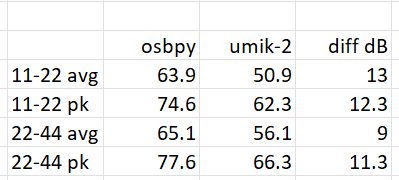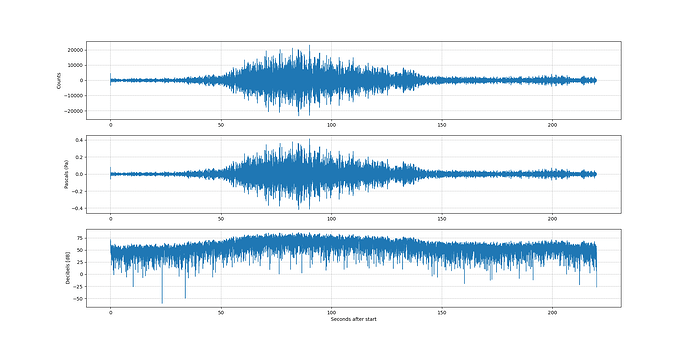I decided to start a new thread now that I have things working.
Summary - my results indicate that the RBoom readings are about 10 dB high versus an actual SPL meter. By implication, the pressure readings are high by about a factor of 4. Or I have made a mistake.
I made measurements on a passing airplane and produced SPL’s for two different frequency octaves using both RBoom and a calibrated microphone good to 10 Hz (umik-2).
Here is the summary:

The routine for SPL using RBoom is from the example
https://manual.raspberryshake.org/developersCorner.html#converting-counts-to-pascal-to-decibel-using-obspy
The code on the developers corner produces this graph with my airplane pass data
if I filter the data to extract 22-44 Hz, I get this:
Real SPL meters usually integrate the sound over 0.5 or 1.0 seconds.
In my code I did 0.5 second integration and it looks like this:
The octave band peak SPL comes out to be around 77 dB peak, down from 80+ in the unfiltered data.
But the result of the octave band is ~77 dB with, or without, the integration feature. With an airplane pass, what the integration mostly does is eliminate those occasional dips to --20 dB, when a single sample value happens to be near zero. If the sound is “impulsive” (gun shots or hammer blows?) then the integration would have a bigger effect.
What does a “real” SPL meter indicate? I used a calibrated USB microphone called UMIK-2. It comes with a calibration file that is compatible with a program called REW. With this combination, the readings should be within +/- 0.1 dB down to 10 Hz. I have checked it with a sound level calibrator that produces 94 dB at 1 kHz and I have, in turn, checked the calibrator against a real type-1 SPL meter - and the numbers are spot-on.
Here is the graphical output of REW:
The green line is the calibration test: 94 dB at 1 kHz.
The orange and blue lines are the readings from my airplane recording showing the peak and the time-average values at each frequency octave band, respectively.
You can see the “real” SPL readings from the real meter are about 10 dB less than what RBoom indicates (when using the formula shown in the developer corner)…
Any ideas why?
(Disclosure - the input piping on my RB has a damped resonance around 25 Hz but I think the effect is less than 3 dB).











